Rolling stock
The first locomotive acquired by the society was a G12 unit number 7707 from the Swedish Statens Järnvägar (SJ). It was built in 1953 in London, Canada and sold to SJ and numbered T42-205 as the sole G12 used by the company. After it was retired in 1986 it was bought by GM-Gruppen.
In 1989 GM-Gruppen agreed to buy two Danish MX/MY units from Danske Statsbaner (DSB), numbered MY-1104 and MX-1040. They were built by NOHAB in 1954 and 1962, respectively.
The organisation also had two Norwegian locomotives, both Di 3 units from Norwegian State Railways (NSB), numbered 3.602 and 3.616. The first is a prototype locomotive while the second is a normal serial production locomotive. Both engines are owned by the Norwegian Railway Museum (NJM) at Hamar, and since 1998 GM-Gruppen has had a ten-year maintenance and operation agreement with NJM for the two trains.
The association also had a number of passenger cars. All rolling stock was sold or returned to the owner after GM-Gruppen lost their operating licence.

Vygruppen, branded as Vy, formerly Norges Statsbaner (NSB) and formerly branded internationally as the Norwegian State Railways, is a government-owned railway company which operates most passenger train services and many bus services in Norway. The company is owned by the Norwegian Ministry of Transport. Its sub-brands include Vy Buss coach services, CargoNet freight trains through and the Swedish train transport company Tågkompaniet. In 2009 NSB carried 52 million train passengers and 104 million bus passengers. On 24 April 2019, passenger train and bus services were rebranded by as Vy.

The EMD F7 is a 1,500 horsepower (1,100 kW) Diesel-electric locomotive produced between February 1949 and December 1953 by the Electro-Motive Division of General Motors (EMD) and General Motors Diesel (GMD).

"Bulldog nose" is the nickname given, due to their appearance, to several diesel locomotives manufactured by GM-EMD and its licencees from 1939 to 1970. The term originated with EMD F-units, as well as later E-unit models such as the E7, E8, and E9.

NSB Di 4 is a class of five diesel-electric locomotives built by Henschel for the Norwegian State Railways (NSB). Delivered in 1981, the class is used to haul passenger trains on the Nordland Line and are since 2001 the only revenue diesel locomotives used by NSB. The locomotives had electric components from Brown, Boveri & Cie and a General Motors Electro-Motive Division 16-645E prime mover. This gives a power output of 2,450 kilowatts (3,290 hp) and a starting tractive effort of 360 kilonewtons (81,000 lbf).
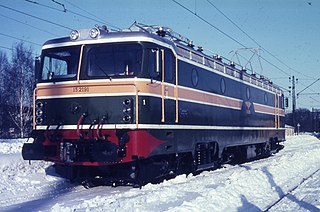
NSB El 15 is a class of electric locomotives which are now operated by the Swedish company Hector Rail as Class 161 locomotives. The locomotives were originally built for the Norwegian State Railways (NSB) in 1967 to replace the NSB El 3 and NSB El 4 engines on Ofoten Line. The main task there is to pull heavy iron ore freight trains, and the El 15 is the most powerful engine which NSB has ever used.

NSB Di 6, later designated ME 26 and DE 2700, is a class of twelve diesel-electric locomotives built by Siemens for the Norwegian State Railways (NSB). The prime mover provides a power output of 2,650 kilowatts (3,550 hp), a starting traction effort of 400 kilonewtons (90,000 lbf) and a maximum speed of 160 kilometres per hour (99 mph). They have a Co′Co′ wheel arrangement. The bidirectional locomotives were designed for use with both passenger and freight trains.
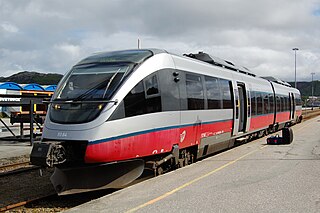
NSB Class 93 is a tilting two-carriage diesel multiple unit used by SJ Norge for passenger trains on non-electrified stretches of the Norwegian railway network. Used on the Nordland Line, the Røros Line and the Rauma Line, they were purchased to replace the aging Di3 locomotive-hauled trains. The Class 93 was produced by Bombardier, and is part of the Talent family. Fifteen units were delivered between 2000 and 2002.

NSB Di 3 is a class of 35 diesel-electric locomotives built by NOHAB for the Norwegian State Railways (NSB). The class was built between 1954 and 1969, and delivered in two series, Di 3a and Di 3b. They are based on the Electro-Motive Division F7 and are equipped with EMD 567 engines. They have a distinct bulldog nose and were numbered 602–633 (a-series) and 641–643 (b-series). The locomotives had a prime mover that gives a power output of 1,305 kilowatts (1,750 hp). The a-series has a Co′Co′ wheel arrangement, while the b-series has (A1A)(A1A). The b-series has higher top speed, but lower tractive effort.

The NSB Di 8 is a class of diesel-electric locomotives built by Maschinenbau Kiel (MaK), while it was part of Siemens Schienenfahrzeugtechnik, for the Norwegian State Railways (NSB). The locomotives are equipped with a Caterpillar 3516 DI-TA prime mover, which provides a power output of 1,570 kilowatts (2,110 hp) and a starting tractive effort of 270 kilonewtons (61,000 lbf).
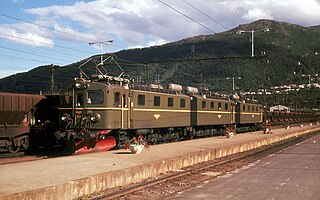
NSB El 12 was an electric locomotive used by the Norwegian State Railways (NSB) to haul iron ore trains on Ofoten Line between 1957 and 1990. The locomotives were based on the Swedish Dm that was used with success on the connecting Iron Ore Line. The eight units were always operated in pairs or in triples and were numbered 12 2113 - 12 2120. Four double sets remain as heritage locomotives.

The class MY is a class of diesel-electric locomotives built in the years 1954–65 by NOHAB. A total of 59 units, numbered 1101–1159, were delivered to the Danish State Railways. Powered by GM-EMD engines, the locomotives represented a significant change in rolling stock policy — motive power had largely been sourced from within Denmark for several decades.

The DSB Class MX is a lightweight, diesel-electric locomotive built by the Swedish company Nydqist & Holm AB between 1960 and 1962 for the Danish State Railways
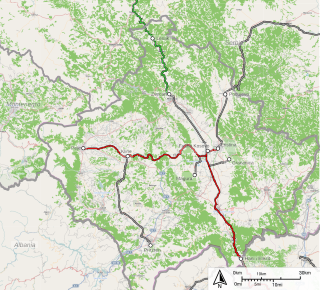
Kosovo Railways, is the national railway company of Kosovo. It was originally formed as the Kosovo Railways J.S.C UNMIK Railways from the lines of the former Yugoslav Railways that lie on Kosovar territory. In 2011, the company was split into two public companies called Trainkos and Infrakos, the latter responsible for rail maintenance.
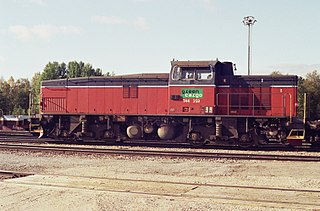
T44 is a Swedish diesel-electric locomotive built by Nydqvist & Holm (NOHAB) and Kalmar Verkstad (KVAB) in 123 units between 1968 and 1987. It was the successor of T43, and used both for hauling and shunting. It is the most common diesel locomotive in Sweden, with state-owned Green Cargo as the largest operator. Other operators include Israel Railways (one), Malmtrafik (two) and formerly Norwegian State Railways and Inlandsbanan AB.

Dm and Dm3 is a series of locomotives used by Swedish State Railways and later Malmtafik i Kiruna (MTAS) for pulling iron ore trains on the Iron Ore Line in Sweden and Ofoten Line in Norway. A total of 39 double-locomotives (Dm) were delivered between 1954 and 1971, built by ASEA. A further 19 center locomotives (Dm3) were later delivered. Norwegian State Railways also operated 12 similar locomotives, designated NSB El 12. The Dm is a articulated, freight-optimized version of the Da-locomotive.

DSB class MZ was a series of 61 diesel-electric locomotives operated by Danske Statsbaner. They were built by NOHAB between 1967 and 1978 under licence from General Motors EMD with subcontractors Thrige-Titan and Frichs. There were four series of the locomotive built, designated I - IV.
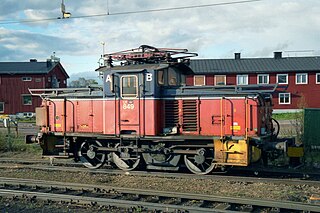
U is a class of 152 electric shunter locomotives operated by the Swedish State Railways and Trafikaktiebolaget Grängesberg–Oxelösunds Järnvägar (TGOJ) of Sweden, and the Norwegian State Railways (NSB), LKAB and Norsk Jernverk of Norway. They were built by ASEA, Nyqvist och Holm, Motala, ASJ Falun and Thune between 1926 and 1956. NSB gave the class the designation El 10.

T41 is a diesel-electric locomotive used by Swedish State Railways between 1956 and 1988 for secondary line services and later shunting. It was built in five copies by Nydquist & Holm (NOHAB) on licence from General Motors Electro-Motive Division.
Material y Construcciones S.A. or MACOSA was a Spanish heavy-engineering company, mainly producing products for the railway industry. From 1989 onwards the organisation was named Meinfesa and became part of the GEC-Alsthom group of companies, until 2005 when it became part of the Vossloh group as Vossloh España, later renamed Vossloh Rail Vehicles. The plant was sold to Stadler in 2015.
The Danish State Railways (DSB) class D steam locomotive was a 2-6-0 freight steam locomotive developed in co-oporation between the DSB central engineering department and the German locomotive manufacturer Henschel. Class D with 100 units became the backbone of the DSB freight locomotives from the start of its delivery in 1902 until the start of the 1950s when the significance of the railway traffic started to decline. Together with the previous deliveries of the heavier 2-8-0 class H freight locomotive and then in 1952 purchased 10 Belgian-built German class 50ÜK locomotives, pushed the class D to the sidelines. When the light GM diesel locomotive class MX was delivered in the start of the 1960s, it was the swansong for class D. Only two class D engines were serviceable when DSB abandoned steam in 1970; D 825 and D 826.


















